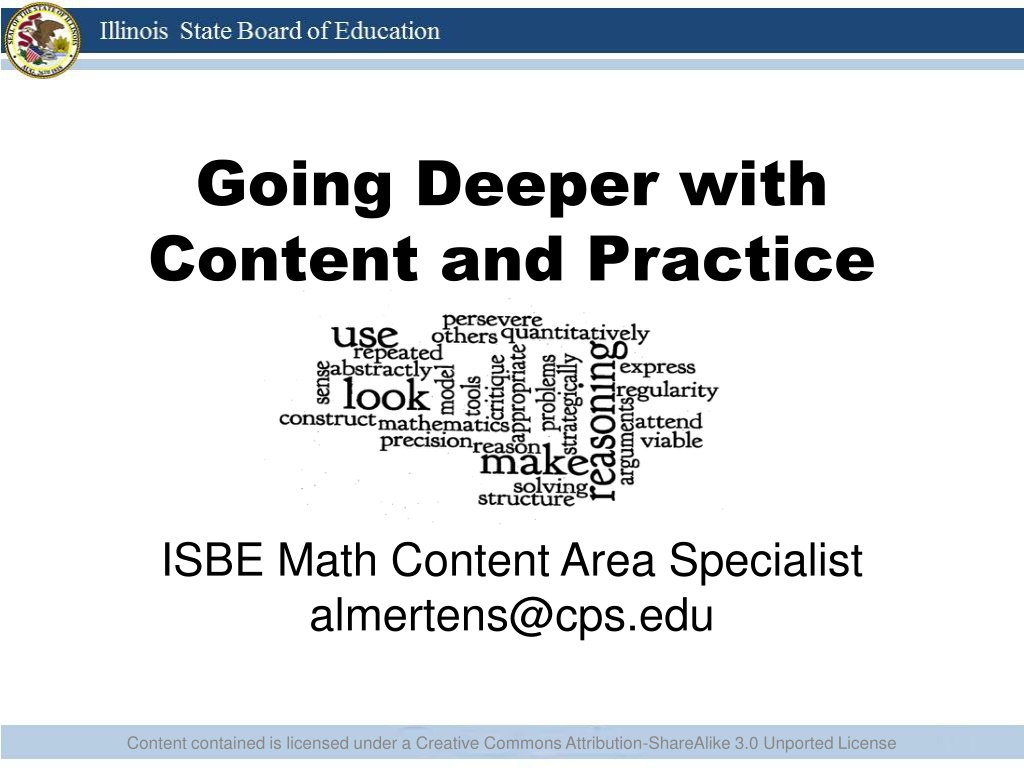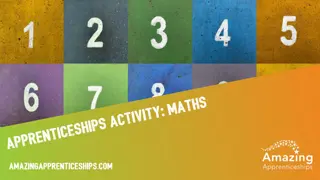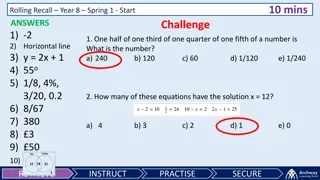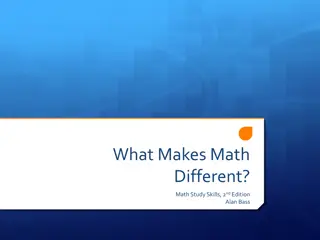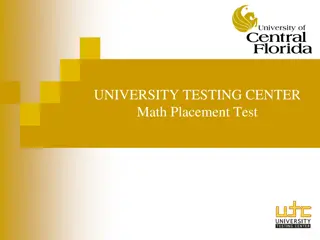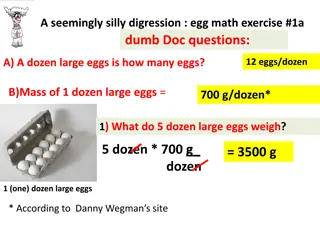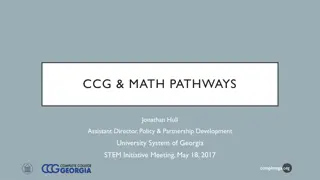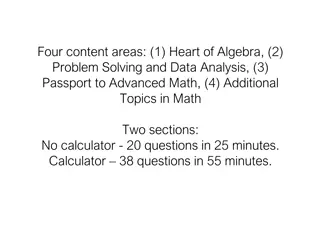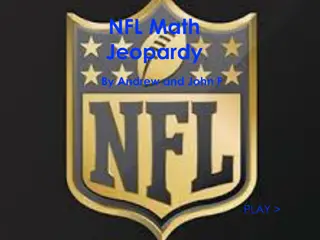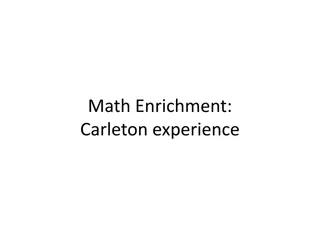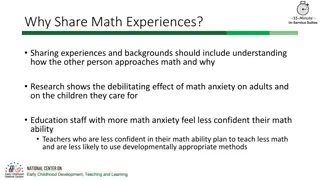Going Deeper with Math Content
In this educational material by Alanna Mertens, explore strategies to integrate Standards for Mathematical Practice, K-5 content shifts, and engaging math activities. Delve into the importance of good listening, productive group work, and envisioning a Common Core math class. Discover the Standards for Mathematical Practice and engage in reflections on incorporating Mathematical Practice Standard 3.
Download Presentation

Please find below an Image/Link to download the presentation.
The content on the website is provided AS IS for your information and personal use only. It may not be sold, licensed, or shared on other websites without obtaining consent from the author.If you encounter any issues during the download, it is possible that the publisher has removed the file from their server.
You are allowed to download the files provided on this website for personal or commercial use, subject to the condition that they are used lawfully. All files are the property of their respective owners.
The content on the website is provided AS IS for your information and personal use only. It may not be sold, licensed, or shared on other websites without obtaining consent from the author.
E N D
Presentation Transcript
Going Deeper with Content and Practice Alanna Mertens ISBE Math Content Area Specialist almertens@cps.edu Content contained is licensed under a Creative Commons Attribution-ShareAlike 3.0 Unported License
Objectives To develop strategies to incorporate the Standards for Mathematical Practice. To explore the K-5 content shifts required by the Common Core State Standards for Mathematics. To experience a math activity that blends content and practice standards. Content contained is licensed under a Creative Commons Attribution-ShareAlike 3.0 Unported License
Why cant we be friends? What does good listening look like? What does productive group work look like? Content contained is licensed under a Creative Commons Attribution-ShareAlike 3.0 Unported License
Standards for Mathematical Practice What do you know about the Standards for Mathematical Practice? The practices are the same for all K-12 students. They define what a mathematical proficient student should be able to do. Take a moment to glance over the practice standards. Content contained is licensed under a Creative Commons Attribution-ShareAlike 3.0 Unported License
Standard for Mathematical Practice 3 Read Practice 3 Make note of some important ideas Be ready to discuss your vision of a great math class that incorporates Mathematical Practice Standard 3. oWhat are the students doing? oWhat is the teacher doing? Content contained is licensed under a Creative Commons Attribution-ShareAlike 3.0 Unported License
Envision a Common Core Math Class What has to happen before we can have students exhibit Mathematical Practice Standard 3? Content contained is licensed under a Creative Commons Attribution-ShareAlike 3.0 Unported License
IllinoisAlaska How does what Mr. Optiz is doing in Alaska relate to Practice Standard 3 here in Illinois? Content contained is licensed under a Creative Commons Attribution-ShareAlike 3.0 Unported License
Instructional Shifts Fluency Coherence Focus Deep Understanding Application Dual Intensity Content contained is licensed under a Creative Commons Attribution-ShareAlike 3.0 Unported License
Coherence and Focus Pick a domain heading and trace the flow of learning across the grade levels. What do you notice? What is most surprising? Content contained is licensed under a Creative Commons Attribution-ShareAlike 3.0 Unported License
Fractions, Fluency and Fun To build fluency we should find ways for students to practice from repeated use through motivational activities --Joan Barrett Content contained is licensed under a Creative Commons Attribution-ShareAlike 3.0 Unported License
4.NF.2 Compare two fractions with different numerators and different denominators, e.g., by creating common denominators or numerators, or by comparing to a benchmark fraction such as 1/2. Recognize that comparisons are valid only when the two fractions refer to the same whole. Record the results of comparisons with symbols >, =, or <, and justify the conclusions, e.g., by using a visual fraction model. Content contained is licensed under a Creative Commons Attribution-ShareAlike 3.0 Unported License
Roll A Fraction 1. Fold a piece of paper in half the long way. 2. Draw a fraction with a box for the numerator, a box for the denominator and a reject box for each player. Content contained is licensed under a Creative Commons Attribution-ShareAlike 3.0 Unported License
Start Rolling! Take turns rolling a die and placing the rolled number in a box on your side of the recording sheet. Once the boxes are filled, decide which player built the greatest fraction. Place the appropriate symbol between the fractions. Play the game several times. What do you notice? Content contained is licensed under a Creative Commons Attribution-ShareAlike 3.0 Unported License
Reflect and Connect Write your strategy for winning. How did you decide which fraction was greater? Who could play this game? What Mathematical Practice Standard(s) were used? Content contained is licensed under a Creative Commons Attribution-ShareAlike 3.0 Unported License
Differentiate the Game Look at the content standard for fractions in grades 3,4,5. Look at the content standards for K,1,2 for counting, adding and subtracting. How could you change the game to align to a content standard at your grade level? Content contained is licensed under a Creative Commons Attribution-ShareAlike 3.0 Unported License
Share and Compare K - Roll a dice to start and end counting 1st - Adding one digit and two digit numbers 2nd - Add and compare whole numbers 3rd - Compare fractions 4th Add and compare fractions 5th - Multiply and compare fractions All - use sticker dots to create the exact practice each child needs Content contained is licensed under a Creative Commons Attribution-ShareAlike 3.0 Unported License
Resources The Illinois State Board of Education Content Area Specialist are here to help! http://isbe.net/ Alanna Mertens almertens@cps.edu Content contained is licensed under a Creative Commons Attribution-ShareAlike 3.0 Unported License
Content contained is licensed under a Creative Commons Attribution-ShareAlike 3.0 Unported License
